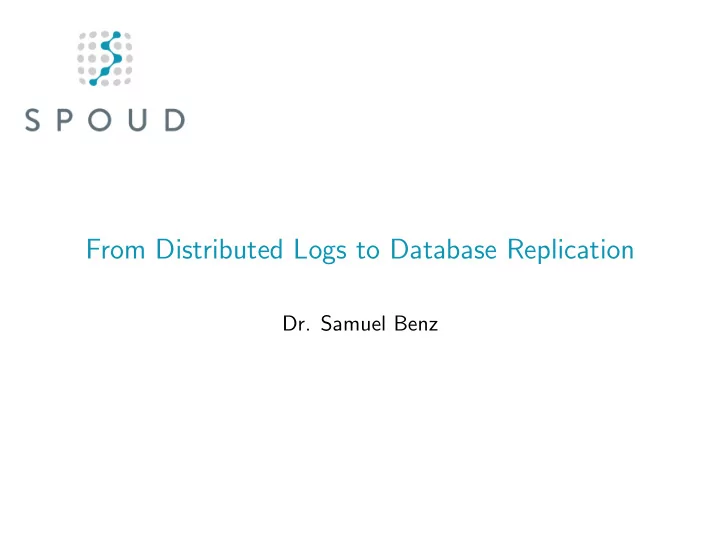

From Distributed Logs to Database Replication Dr. Samuel Benz
How to achieve scalability, fault tolerance and consistency in distributed systems?
Distributed applications in theory. . .
. . . in practice
Introduction Reliable and Scalable Services Distributed Consensus Distributed Log Conclusion Why do we see such architectures? Distributed Stateful Components state (vs. stateless) shared > 1 client (isolation) mutable > 0 writer (concurrency) distributed > 1 DB (consistency) geographically > 50 km (latency) 5
Introduction Reliable and Scalable Services Distributed Consensus Distributed Log Conclusion Reliable and Scalable Stateful Services Problem 1 Scalability: • Size: Internet scale services • Location: Access latency • Administration: Multiple organizational units 2 Fault-Tolerance Solution 1 Distributed Data: Replication 2 Distributed Computing: Coordination 6
Introduction Reliable and Scalable Services Distributed Consensus Distributed Log Conclusion Different Types of Replication 7
Introduction Reliable and Scalable Services Distributed Consensus Distributed Log Conclusion State Machine Replication → Fault-tolerance 8
Introduction Reliable and Scalable Services Distributed Consensus Distributed Log Conclusion State Machine Replication → Consistency 9
Introduction Reliable and Scalable Services Distributed Consensus Distributed Log Conclusion Partitioning → Scalability 10
Introduction Reliable and Scalable Services Distributed Consensus Distributed Log Conclusion Consistent Partitioning 1 The system ensures strong consistency within partitions and ”best-effort” across partitions. 2 The system ensures strong consistency using 2PC across partitions. 3 The system orders commands before executing them or checks their order after executing the commands ( Atomic Multicast ). 11
Introduction Reliable and Scalable Services Distributed Consensus Distributed Log Conclusion Simple Coordination Problem A B 12
Introduction Reliable and Scalable Services Distributed Consensus Distributed Log Conclusion Consensus Problem Fundamental Result No algorithm can solve consensus in an asynchronous system despite a single crash. FLP impossibility result (after Fischer, Lynch, and Paterson, 1985) 13
Introduction Reliable and Scalable Services Distributed Consensus Distributed Log Conclusion Consensus and Atomic Broadcast In a crash-stop failure model consensus is defined as follows: 1 Termination: Every correct process eventually decides. 2 Agreement: No two correct processes decide differently. 3 Uniform integrity: Every process decides at most once. 4 Uniform validity: If a process decides v , then v was proposed by some process. Additionally Atomic Broadcast : 5 Total order: If two correct processes p and q deliver two messages m and m ′ , then p delivers m before m ′ if and only if q delivers m before m ′ . [Chandra et al . Unreliable failure detectors for reliable distributed systems. 1996.] 14
Introduction Reliable and Scalable Services Distributed Consensus Distributed Log Conclusion Consensus and Atomic Broadcast In a crash-stop failure model consensus is defined as follows: 1 Termination: Every correct process eventually decides. 2 Agreement: No two correct processes decide differently. 3 Uniform integrity: Every process decides at most once. 4 Uniform validity: If a process decides v , then v was proposed by some process. Additionally Atomic Broadcast : 5 Total order: If two correct processes p and q deliver two messages m and m ′ , then p delivers m before m ′ if and only if q delivers m before m ′ . [Chandra et al . Unreliable failure detectors for reliable distributed systems. 1996.] 14
Introduction Reliable and Scalable Services Distributed Consensus Distributed Log Conclusion 15
Introduction Reliable and Scalable Services Distributed Consensus Distributed Log Conclusion Distributed Log 16
Introduction Reliable and Scalable Services Distributed Consensus Distributed Log Conclusion Distributed Transactions 17
Introduction Reliable and Scalable Services Distributed Consensus Distributed Log Conclusion Distributed Data Structures 18
Introduction Reliable and Scalable Services Distributed Consensus Distributed Log Conclusion Kafka Consistency 19
Introduction Reliable and Scalable Services Distributed Consensus Distributed Log Conclusion Kafka Scalability 20
Recommend
More recommend